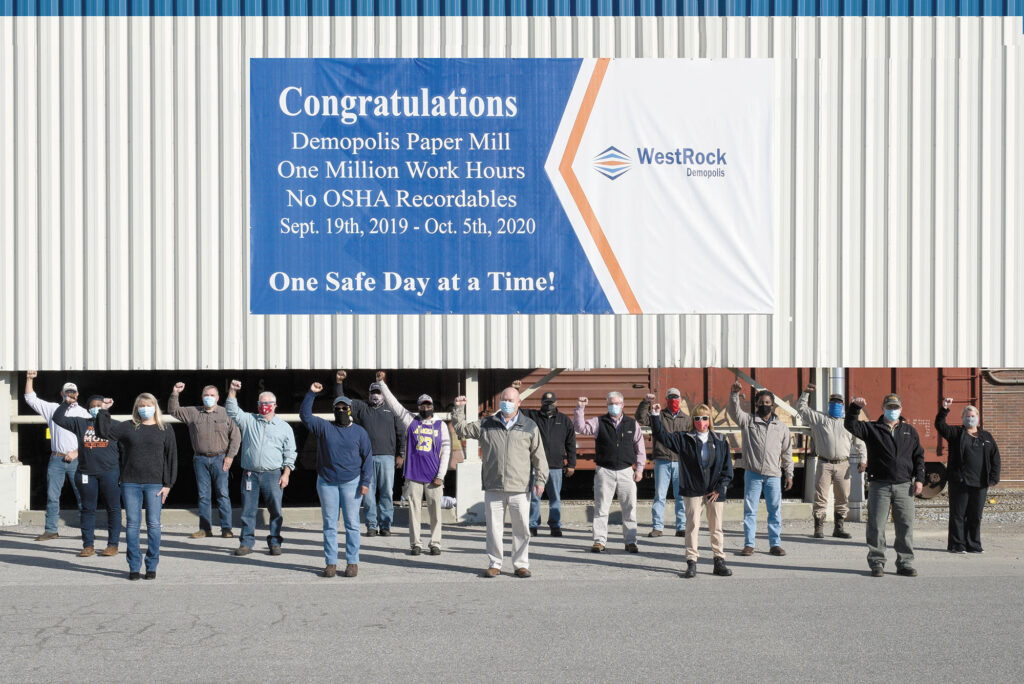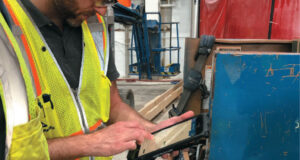JAN BOTTIGLIERI
When it comes to safety, WestRock must be doing something right. In 2020, the Pulp and Paper Safety Association (PPSA) presented two major safety awards to WestRock employees for their 2019 safety accomplishments. Safety Leader of the Year is the Eaton, IN, mill’s Carrie Andecover, who helped energize her mill’s safety team through personal engagement; the Safety Team Award honored WestRock’s Demopolis, AL, mill for, among other things, its innovative valve labeling initiative.

In October 2020, Demopolis hit another incredible milestone: one million work hours with no recordable incidents. WestRock CEO Steve Voorhees visited the mill and invited the hourly safety team members to be recognized at his leadership presentation.
Personal connection is key to WestRock’s safety success. That’s a tall order for a company that has grown rapidly since its formation five years ago and now boasts 50,000 teammates at more than 320 manufacturing sites around the globe. To learn more, Paper360° spoke with some of the company’s safety leaders: Carrie Andecover, safety manager at the Eaton Mill (read her story on page 10); Matthew Kanneberg, director of health and safety, Consumer Mills Division; Allison Montgomery, vice president, health and safety, at WestRock corporate; and Craig Dukes, safety manager at the Demopolis mill.
Paper360°: How would you characterize the “safety culture” at WestRock?
Kanneberg: We have a caring culture at WestRock based on our four key values: integrity, respect, accountability, and excellence. We strive to achieve involvement and ownership at all levels of the organization.
Our goal is “100% Safe.” That means a lot of things to a lot of people; but we communicate it as striving for perfection in safety. It also means being safe 100 percent of the time. We want to instill the value that our teammates must strive to be safe no matter where they are—at home, at play, in transit to work, and of course at work.
Dukes: In order to have a safety culture, you’ve got to start with a culture of caring about each other. Once you build that bond, it takes off from there.
Getting everyone aligned to a common goal is a challenge, but success is contagious. We have gotten our share of recognition for safety, and fewer and fewer people are getting hurt—that’s my passion. I want everyone going home the same way they came to work. Actually, not just the same, but better, because they can teach their families about safety.
Montgomery: Saying our goal is “100% Safe” is saying we want to drive toward perfection, and as human beings we know that perfection is a constant aspiration. We will always push ourselves toward that goal. When you value safety and care about each one of your teammates, what other answer is there? We’re not going to say, “We strive to be 90 percent safe.” That is not acceptable.
Paper360°: Can you give me an example of that level of employee engagement?
Montgomery: Sure! I’ll give you two examples. The first is our “Courage to Care,” which basically means that our leaders actively display that we care about our people. We have many smaller, safety-driven initiatives that are part of Courage to Care; some of our safety leaders have one-on-one, scheduled conversations with each teammate. Another site calls it “What About Me?” and on a large board inside the facility, they have a picture of each teammate with their family. Our Brazilian site filmed videos of family members talking to their fathers and mothers, telling them how much they loved them and wanted them to work safely and come home to them.
We are developing a framework that any site will be able to use. It will include all of our best practices as part of the Courage to Care focus; the location will receive an implementation toolkit and guidelines on how to get started. We’ll show all of the different options, because some may be more successful than others, based on existing culture at that location.
On a more granular level, we are rolling out a program called High-Risk Task of the Day; again, it’s about communication and engagement. Leadership—supervisors and area managers—come together before every shift to talk about the plan for the day. They discuss the one thing they’re doing that day where they worry someone could get hurt, which we would call an exposure. It might be something they’ve had an issue with before; there could be many factors. After leaders have that discussion, the manager of the area where that high-risk task will take place will plan with his teammates how they’re going to overcome that exposure. What are they going to do to stay safe?
Then, when they’re ready to execute that task, the leadership team actually comes to observe. They talk to the teammates about how they’ve decided to mitigate that exposure and then they actually perform the task. It’s a great way for leaders to actually see the hurdles our teammates are dealing with every day.
Kanneberg: One of our strategic targets is around the reduction of exposure for risks we’ve identified that can cause harm. We’re focused on the elimination of Life Changing Events (LCEs)—that is our term for serious injuries and fatalities (SIFs). We don’t want anyone to be hurt at all, but we’re going to put more rigor and focus on things that could have life-changing consequences.
While LCEs are our first priority, that’s only a small subset; there is a lot more to work on—for instance, ergonomics. We don’t want to mold the people to the workplace; we want to do it the proactive way, where we make the work fit a diverse community. We’re all a little bit different in how we think, how we move, and our physical capabilities.
Paper360°: Right—because you can control the environment more easily than you can “control” the individuals. They need to do it themselves.
Kanneberg: Exactly. I look at safety from two ways: the art and the science. The science is all the physical attributes; the art is the human mind. The most challenging aspect of safety is how to understand, anticipate, and influence an individual mind. The “science” includes OSHA compliance rules and procedures, all the tangible things; but what matters is, when it’s 2 o’clock in the morning and nobody is around, how do we influence an individual’s mind to make the right, safe decision?
Dukes: I agree. You don’t need to change everybody’s viewpoint at once, as long as everyone strives to get on board and is accountable as a team. Our challenge is conveying the “why” and value of safety to get the best safety engagement. As long as you can positively influence their actions, the results will change their minds. From what I’ve seen from corporate reports, even on a global scale, every metric is heading in the right direction for WestRock.
Kanneberg: Historically around performance, we spent a lot of time looking at our failures. Those are lagging indicators: how many people were hurt? How many people went to the doctor? All those things are important, but we also need to understand the flip side: i.e., what are the leading indicators that actually drive excellent performance?
WestRock continues to find ways to measure performance on a leading, proactive scale, balanced with a mix of lagging indicators. We’ll never get away completely from lagging indicators, and we shouldn’t; but we’re trying to focus improvement on the engagement side and proactive drivers that influence safe actions.
Paper360°: How do you communicate safety procedures and values to new employees—some who may already have some very ingrained ideas about how safety is “done,” and others who may have never worked in a manufacturing environment?
Montgomery: Communication is part of everything we do. We want to make sure we’re getting feedback from our teammates when we’re making our decisions.
Kanneberg: Our commitment to safety begins at the top with our CEO Steve Voorhees and the steering team. At the next level down, he has appointed our Safety Council, which includes leaders from all levels of the company. They review data and drive a hierarchy of strategy, and that cascades down to the individual operational divisions. This consistent approach and alignment influence the new team members as they assimilate into our culture.
Paper360°: Is there a process for information to cascade back up?
Montgomery: Yes. As leaders, we’re not the experts on the daily work. We ask our teammates to identify what they’re doing that they consider high exposure or risk. Then our leaders need to be engaged and intentional: what are we doing about risk? Our teammates need to tell us what their risks are, and they need to keep us accountable for what we’re doing about it. And as leaders, we need to hold ourselves accountable, and we need to give them feedback to close that loop.
Kanneberg: We strive to engage team members at all levels. Fostering a learning organization facilitates learning from each other. We strive to learn from our successes, our failures, our innovations—all of which drive closure to our gaps and risk exposures.
Dukes: At our mill, we also use a mentoring process. When a new hire comes on board, they go through an entire week of safety training before they even see mill operations. Then, one of our safety committee members is that person’s mentor for the next 12 weeks. We have a different safety questionnaire each week the mentor will go through with that new hire. It has really worked out well, because if I ask a new person, “How’s everything going?” they’re going to say “Gee, Craig, everything’s going great.” But if an hourly safety committee person talks to them, they’ll open up a little more.
Paper360°: Even a strong safety culture can be challenged. What do you do about “safety pushback”?
Kanneberg: As we say—communication, communication, and communication. Safety is a common denominator for everyone. Because WestRock starts with that lofty “100% Safe” goal, it is rare that we are misaligned on the strategy. Alignment comes through constant dialogue, especially on high-risk exposures. Pushback is inevitable, especially around a topic that is so personal; but that pushback is typically related to “how” we address a safety issue vs. “why” we address safety. Open dialog with a nonthreatening approach is the best way to resolve safety issues.
Dukes: Exactly. Safety pushback will always be there, but at Demopolis there is no compromise on safety. Employees are encouraged to bring up new and improved ideas to enhance safety, too.
This mill’s been around since 1957, but 2020 had the best safety record in its 63 years. Carrie Andecover,
PPSA Safety Leader of the Year
Our safety committee won the PPSA award, then a few months later (on September 18) we hit one year without an OSHA recordable incident. On October 5, we crossed the “Million Work Hours” milestone without an OSHA recordable incident. And we just got through November incident-free—not even first aid. It’s pretty phenomenal!
Montgomery: Our governance structure is a critical element of our process. Everything we want to do goes through both the Steering Team and our Safety Council, and they help us determine what obstacles we might encounter. This helps us create a strategy that will be successful. Then business leaders from the Safety Council often present the new initiatives at the mill level. Hearing it from local leaders goes a long way toward buy-in.
Also, we can be flexible. A great example is, we just rolled out a new exposure reporting system for the entire company, but a lot of sites were already doing something similar. We don’t need to change everything at those locations. We will focus on minimizing re-work and taking advantage of the good things they already do.
We’ve developed a whole new strategy with many initiatives, and the truth is…we get very little pushback. We have great support! I believe that is because we spend so much time communicating and listening to ideas and feedback, which ultimately leads to getting buy-in from multiple levels of the organization.
Paper360°: Craig, your team designed a new valve labeling system to reduce risk at your mill. Valve labeling is not new—what made this initiative special?
Dukes: The project was conceived by input from our teammates. We modified the labeling process by using color-coded tags to designate the material in each valve or line. Each tag specifies the asset number, which takes away any uncertainty when you’re performing a Lockout/Tagout procedure, ensuring you are working on the proper valve. Every mill has thousands of tags to lock out, and improper LO/TO can put someone in harm’s way very quickly.
For instance, if I’m a maintenance teammate coming out to work on a valve, I have no idea what material is circulating within that valve. It could be water, it could be highly caustic, it could be flammable. The color-coding lets me know what material I’ll be dealing with—so a blue tag with white lettering designates water in that valve or line, a black tag with orange lettering specifies a caustic material.
Paper360°: Colors are such a quick visual clue! That sends the message “We want to make it as easy as possible, as soon as possible, to be as safe as possible.”
Dukes: Yes. I do believe that this project helped us win the PPSA award, but our committee has done a lot. A great example is that the local high school invited us, so four safety committee members and I went and spoke to the students—juniors in an industrial vocational curriculum. Each member took on a subject that pertains to teenagers: cell phone use and texting; chemicals in the house; things in the medicine cabinet. We talked to 85 students in three different classes. The teachers were just thrilled.
Our commitment to safety goes beyond the workplace. It was a way to demonstrate our passion for safety through community outreach. We’re the biggest employer in the area, so most kids have someone in their family working out here.
Paper360°: You’re communicating that WestRock has high expectations for safety. Won’t some of those kids end up seeking work at your facility?
Dukes: Exactly—we’re planting the seeds for the future. Plus, we recognize and reward our teammates for milestones, so many of their moms or dads came home with a commemorative gift in honor of our million work hours without a recordable incident. We have 475 employees; I’m sure the parents pass these achievements along to the kids.
They say you’re 10 times as likely to get hurt at home compared to work, likely because there are safe processes at work. But a lot of what our employees are learning here is getting carried home, and that’s pretty neat.
Paper360°: Can you assess the real value of safety for WestRock?
Kanneberg: To me, it’s fundamental to our four core values of integrity, respect, accountability, and excellence. There is one sure way to derail each of those values, and one sure way to find success. And the basis for our success is the sincere care we demonstrate to our fellow teammates. We can’t just say we want to be safe. We need to actively demonstrate that in all we do.
Montgomery: Dedication to safety is fundamental for business. It will help you build the skill set for treating employees with care. It will help you have conversations with teammates. Our teammates are the reason we’re successful, and they want to work somewhere safe, with leaders who care about them.
Safety is absolutely a competitive advantage because, frankly, you want your teammates happy. If you’re happy to come to work and you feel respected and safe in what you do, you’ll work hard—and all of those other things fall into place. Quality’s not a problem; people meet their time commitments; they meet their production goals. It all flows from feeling safe.
Safety is universal. It doesn’t matter if you’re running a box plant or a mill, it doesn’t matter which industry; we can all talk about safety. And if you do that with love and care, you will garner support. We don’t always feel comfortable discussing this “squishy stuff”; most safety dialogue is about processes and systems, and those are very important. But that culture of caring is critical, and it takes a lot of effort.
Paper360°: That’s what makes safety such a great touchpoint, right? It’s one thing we can internalize to apply anywhere in our lives.
Dukes: It’s everywhere we go; it’s certainly a focus in every department at my mill. Our valve labeling initiative is ongoing, but we have many other projects in our pipeline that will enhance safety at our mill. If other mills could get a robust committee going, it really benefits the entire mill. I know it helps me.
Our safety efforts have really blossomed. I use the analogy that it’s like building an orchestra: you start with the string section, and then all of a sudden the horns come in. Then you add the percussion, then the woodwinds, and pretty soon you’ve got a big group playing the same song. Our crescendo was 2020… and we’re still playing.
 Paper 360
Paper 360

